Remembering on Marty’s Day the forgotten Eritrean Hero Debesai Gebreselassie
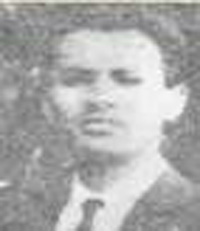
Compiled and researched by Resoum Kidane
19/06/21
Introduction
During the liberation struggle many nationalist Eritrean fighters who had joined the EPLF and ELF were eliminated by the Fronts, among them was Debessay. He joined the EPLF in the early 1972 and was executed in 1979.
On Martyrs' Day, it is very painful for the families of the fallen martyrs like Debessay to be reminded that they were never officially told about the deaths of their loved ones when, in 1993, the then Provision Government of Eritrea announced their names.
His name is also never mentioned by the diasporas human rights activists, civil society or opposition groups A question could be raised here why this is when each year on the 18th of September and 14th of April other post-1991 victims of the PFDJ are recalled
This piece of compilation is to honour Debessay and his comrades who dedicated their lives to the Eritrea Independent struggle but were executed by their own organisation in the 1970s for challenging the EPLF leadership system. It is also to honour the ELF fighters who were also killed by their own group for challenging the ELF leadership in the 1960s and 1970s. Hopefully, Debessay and his comrades will be remembered in future by the young generation.
Personal background information
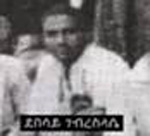
Early life in Mendefera
. .
Debessay was born in the village of Adi Bana at Guhu Chia close to Mendefera in the early 1940s. Debessay was one of the first generation of students from post-Italian colonialism who received his education after the revival of modern education system by the British Military Administration (BMA) in 1942. After the Italian segregated education system was abolished, the Eritrean people showed their keenness to educate their children through building schools in their local areas. .
Trevaskis, (1960, page 34]) states that educational development aroused an unexpected enthusiasm amongst a large number of Eritreans, despite the fact that the British asked for the Eritrean population to fund some of the school building. The significance of this is that the British were not prepared to spend their own money but left it largely to the impoverished Eritrean population who took initiative to build school in their villages.
Regarding this Taye (1991:59) describes how some poor people sent a pig, a sheep or a cow to the market in order to provide a share in the cost of hiring builders with adequate tools, experienced quarrymen and masons to quarry the required, grey stone of the mountains. As a result of this, no fewer than 59 villages erected their own schools in the late 1940s which contributed considerably to enable the young and middle-aged gaining access to education in their own villages.
Institutes were also established first in Asmara, and then in other towns like Mendefera where Debessay was able to access education. Debessay attended (elementary and middle school) at San Giorgio (ሳንጆርጆ) school in Mendefera from 1951 to1959. According to Tesfa G. Gebremedhin (2017) who graduated from San Giorgio School with Debessay in 1959, the San Giorgio School was started as an elementary school from first to fourth grade during the Italian occupation. When that ended in 1942, the school was restored as a middle school during the Federation in the early 1950s (2017)
Emnetu Tesfai recalled that Debessay was very good at school and always among the top- ranking student. Other people who knew him also recalled that he was patient and had enormous charm and a great sense of humour.
Debessay as Member of Haraket and professional teacher
1959-1967
After Debessay graduated from San Giorgio (ሳንጆርጆ) middle schools in1959, he joined the Teacher Training in Asmara (TTI) which was opened by the British Administration in 1946.
During the Federation period, the teaching training was extended from one year to two years, and the teacher training colleges became the main supplier of teachers for both primary and middle schools in Eritrea. (Kidane, 2017). As can be seen from Table 1 the training colleges and the number of government school teachers over a period of six years (1955/56-1960/61) grew over 68 %( Taye 77-7
Percentage increase of Teachers (1956-57 to 1959-60) |
||||
|
1956-57 |
1957-58 |
1958-59 |
1959-60 |
Teachers Empire total |
15.33 |
11.14 |
13.31 |
2.35 |
By and large the British educational system in Eritrea had not only enhanced the educational awareness and the number of teachers but also played a role in increasing the political consciousness of the people and particularly of teachers. The Eritrean teachers like Debessay did not confine themselves to professional matter but also involved themselves in politics in the 1950s as well as during the 30 years of liberation struggle.
Debessay and his generation were influenced by their teachers and by Ato Woldeab Woldemariam’s radio broadcasts from Cairo in the 1950s. Ande Michael Kahassa who was a student at San Giorgio (ሳንጆርጆ) school with Debessay, in his interview explains: ‘I was 14 and in the sixth grade when we had our first Amharic class. By then Wolde-Ab was broadcasting from Cairo. You could hear the grown-ups talking about it. We did not have a radio at home, but in the tea-shops and so on, people listened to Wolde-Ab.
While Debessay was a student at the San Giorgio (ሳንጆርጆ), he was also influenced by the singing and drama productions of the Mah’ber Memheyash Hagarawi Limidi (Association for the Development of National Culture M.M.H.L).
M.M.H.L was founded in 1957 when its 45 members staged several singing and drama performances in Mendefera and at the Cinema Impero in Asmara (attended by 3,000). Amine Gebre-Kirstos a participant and worker at the Government Printing Press, along with two other M.M.H.L members were imprisoned and tortured for 3 months following the Asmara show [Kidane , 2018]
In 1957, the first student strike occurred at the Haile Selassie Secondary School in Asmara (now the Red Sea Secondary School) in protesting to the imposition of Amharic as the language of instruction in schools
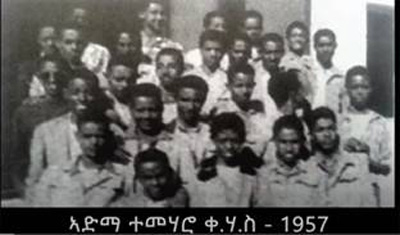
Many will have heard about the students demonstration against the imposition of Amharic as the school's language of instruction in 1957 Unfortunately there has been little acknowledgement of contribution of the Asmara Teachers' Association who encouraged, or influenced their students to protest against the imposition of Amharic, and for the unequal wages between Eritrean and Ethiopian teachers. Eritrean teachers at that time had a starting salary the equivalent of $20, later it became $80, whereas the starting salary of the Ethiopian teachers was $250,
A year after first student strike, the Asmara Teachers' Association and School Teachers Union also participated in the 1958 general strike which was organized by the Workers' Syndicate against the Ethiopian authorities over the dismantling of Eritrean status. After the General Strike the Asmara Teachers' Association and School Teachers Union were banned and the Asmara Teachers' Association leaders (such as Assays Tesfai, A bebe Yasin & Tsegai Negash) were briefly arrested,
Although the School Teachers Union was closed , Eritrean teachers continued their participation in the civic and political rights struggle through joining the underground organization Haraket and the Asmara Theatre Association ( MATA) in the 1950s and 1960s respectively .
All the above contributed to Debessay to involve actively in the Eritrea politics in the 1950s and 1960s
Debessay was one of those students at the TTI who joined Haraket when its network was spreading among the youth, workers and professional teachers in Asmara. Debessay and other member of Haraket went on strike to protest the dissolution of the Eritrean Assembly and the illegal annexation of Eritrea on November 14, 1962.
As shows in the picture below Woldenkel Abrha who was a teacher and member of Haraket made clear his firm opposition against the annexation of Eritrea in his Slogans “Free Eritrea or Death”: hepreferred to die rather than see the annexation of Eritrea.
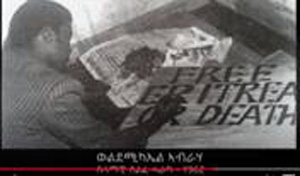
Following the strike, the protesters, Debessay, Woldenkel Abrha and other members of the Haraket, were arrested. Later Tedla Uqubit released them in 1963. The picture below was taken when the prisoners released, Debessay sitting in the first row.
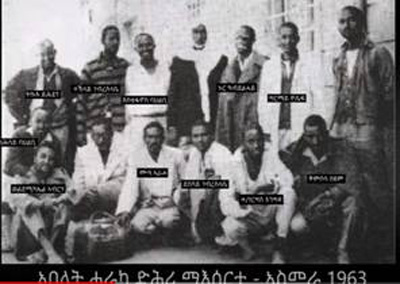
ትኩእይሕደጎ; ተኽላይገብረስላሴ (ሓራካ); አስቲፋኖስ; ባህልቢግርማይዮሴፍ; ኑርአብደላ; ካሕሳይባህልቢ ;ወልደሚካልኣብርሃ; ሙሳኣራሖ; ደበሳይገብረስላሴ; ተስፋጊዮጊስአንግዳ; ቶምቦሳስዮም;
ኣብቲኣንጻርምፍራስፈደረሽንተቃዊሞምዝተኣሰሩኣማእትመንእስያት፤መንግስቲነቶምዝበዝሑክፈትሕንከሎ።ዓሰርተንዝኾኑግንአጽንሖም።እቶምቀንዲዝዝከሩእዚኦምዝስዕቡኢዮም።ትኩእይሕደጎ፤ተኽላይገብረስላሴ (ሓራካ)፤ሙሳኣራሖ፤ወልደሚካልኣብርሃ፤ደበሳይገብረስላሴ፤አስቲፋኖስባህልቢ፤ግርማይዮሴፍ፤ኑርአብደላ፤ማሕሙድኢስማዒልነዊሕግዜኣብማእስርቲኣጸንሑን።ሐደመዓልቲ፤ኢሉተኽላይ (ሓራካ)
ተድላዐቑቢትባዕሉናብቤትማእሰርቲመጺኡአከበናንስኻትኩምስለምንታይንበይንኹምኣብከምዚዓይነትስቅያትትወድቁኢሉናኣበይአለውአቶምዓበይቲኢናዝብሉምሳኹምዝነበሩሰለምንታይከዝይተሐባበሩኹምቪላታትኮንቸስዮንኣብምጥራይአዮምዝርከቡዘለው።አቲክትገብሩዎዝግባኩምዝነበረንዓይመጺአኩምከተካፍሉኒአዩ።ነቲኽግበርዝከአልግበሩዎምበልኩኹምነቲዘይከአልከኣምኽልከልኩም።አዚብዘይምግባርኩምተሳቒኹም።ሕጂግንናጻለቒቐኩምአሎኹኢሉስምኢትዮጲያዋላሃይለስላስሴኸየልዓለፈቲሑናወጺአና።
Source facebook ዛንታ ፖሊስ ቁ 32ማእሰርቲ ፍሉያት ሰባ
After the annexation, education started to go into reverse as educators became the target of repression, incarceration and torture in the late 1950s In 1963, the elementary and secondary teachers were unhappy at the Ethiopian government's policies and were active in clandestine nationalist organizations (Kidane)
After Debesai Gebreselassie was release from prison in 1963, he went back to his teaching profession.
Although Debessay spent his professional years at Kudo Abur until 1967 he was actively involved in politics and dedicated his live to the Eritrea Independent struggle as did Naizghi Kflu, Ande Michael Kahassa, Kidane Kiflu and Woldedawit Temesghen who all studied at San Giorgio (ሳንጆርጆ) school in 1950s. Emnetu Tesfay describes Debessay as a man with principle and courage
In 1967 while Debessay was teaching at Kudo Abur he sat for the Ethiopian School Leaving Certificate Examination (ESLCE) and passed his exams. According to Tesfa Gebremedhin email correspondence, Debessay and he graduated from St. George Middle School in 1959 and both of them joined Haileselassie I University in 1967. Their University national service was in 1970/71
Student at the Haile Selassie I University
1967-1971
Debessay was a mature student with high political consciousness when he joined the Haile Selassie I University in 1967. His political awareness was strongly influenced through participating in various demonstrations against the political and civil rights violations committed by Emperor Selassie’s regime in Eritrea against the rising Eritrean nationalism in the 1950s
By and large, prior to 1967, the Eritrean students of Debessay’s generation were more opposed to Emperor Selassie than the Ethiopian students who started to protest against the regime in 1967.
According to Reddebrek (2017), in 1967, the students’ movement became more cohesive. A major theme that drove the movement was anti-Western influence and the opposition to the large military presence that the US had in Ethiopia at the time. Ahmed, Hussein (2006) also states that the late sixties and early seventies were a period of ideologically-informed discussions of political issues such as the national question with reference to self-determination and secession, a timely subject connected to the armed struggle in Eritrea.
All the above considerably contributed for Debessay to be one of leftist students and a dynamic actor in political activism in the campus during his studies between 1967 and 1971. Throughout those years he also contributed to developing a strong solidarity between Ethiopian progressive students on the campus though working together with other progressive students like Yohannes Sebhatu, Temesgen Haile, Berhane Meskel, Walel, Amanuel Yohanes etc.
According to Petros Tesfa Giorgis who was one of the progressive student at that time, the Ethiopian University students were the most radical students in Africa and the Eritrean progressive students came to realize that if the oppressive feudal system was to be replaced by a socialist Government the problem in Eritrea could be solved peacefully based on the right of people to self-determination. ( Tesfa Giorgis (2007)
Indeed both the Eritrean and Ethiopian progressive students played a key role in the student movement in the late 1960s and early 1970s. During those years Debessay got an opportunity to collaborate with Eritrean progressive students such as Amanuel Yohannes Gorki) to hijack the Ethiopian plane while he was in .his University service called Ethiopian University Service (EUS) in 1971.
The EUS was a mandatory service that students had to do after completing their third year and before their fourth year. According Abeba Yirga (2021), in 1964, the Ethiopian University Service was developed as a degree requirement in which students were expected to work one year (at the end of the third year) in the provinces, mostly as teachers. This system also contributed to disseminating campus politics to a much wider population outside the university, raising consciousness among secondary school students.
Mussie Tesfamichael who was in EUS 1970/1971 is a good example. He played an active role in raising consciousness among his students at the San Giorge secondary school before participating in the 1971 hijacking with Debessay.
On January 23, 1971 Yohannes Sebhatu, Amanuel Yohannes, Mussie Tesfamichael and Debessay hijacked the Ethiopian plane from Bahr Dar to Khartoum then diverting it to Benghazi, Libya. Their aim was to draw international attention to the atrocities committed by the Ethiopian forces against the Eritrean people. Indeed their action was reported by the New York Time and the Sudanese radio.
The New York Time on 23 of January reported: “an Ethiopian airliner was hijacked today to Benghazi, Libya. It made refuelling stops in Khartoum, the Sudanese capital, and in Cairo. There were 23 persons aboard.”
The Sudanese radio also reported that the hijackers were Eritrean students who had threatened to blow up the plane, a DC‐3, during its two‐hour stopover in Khartoum and had made the same threat in Cairo, where they asked for and received fuel and food. According to Bahru Zewde ( 2014) the hijackers chose to go to Libya but eventually joined the EPLF.
Debessay joined the EPLF
1972
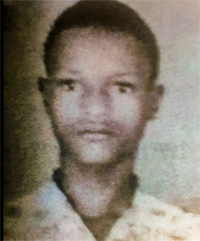
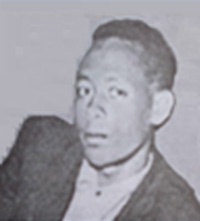
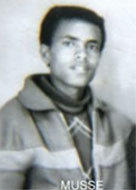

Yohannes, Amanuel, Musie and Debesai
Emnetu describes Debessay as a man in whose conduct he firmly believed, and who travelled without distraction like smoke and, indeed his nickname, was ትኪ tki (smoke) because it meant that he would not lose his way out.
Debessay was one of the many young people of his generation like Tukue Yehdego who had the vision, commitment, determination and discipline to devote his life to the Eritrea independence struggle and to realise a truly free Eritrea.
Debessay, Yohannes Sebhatu, Amanuel Yohannes and Mussie Tesfamichael who hijacked the Ethiopia plane joined the EPLF (PLF Group 2) in the early 1972.
After the hijackers arrived at Gereger Sudan where the EPLF’s (PLF) base area was located, Yohannes was appointed immediately as director of publications and information because he had previous experience of working for the Ethiopia Herald. Musie was also appointed as head of political education in the training camp, Amanuel Yohannes was sent on a mission to Addis Ababa from Gereger Sudan, and Debessai was appointed as political commissioner of platoon.
At the time, Debessai was assigned to the Ibrhim Afa’s Hayli (company) as the political commissioner of the platoon, when they were about 6-7 Haylitat (company), including the Kifletat (department). One Hayli comprised of 50-60 fighters.
When Debessay joined the EPLF (PLF) there was a tension between the ELF and PLF,. There was an attempt to reconcile their differences when the ELF and PLF groups met in Aden in the early 1972. From the ELF’s side one member was Saleh Eyay and from PLF’s side, Yohannes Sebhatu, among others but they failed to reach an agreement which then lead to the outbreak of the 2-year civil war that began in Spring of 1972 and lasted until October 1974
Although Musie and Yohannes, who joined with Debessay, were appointed to key positions, Isaias was uncomfortable, particularly with Musie and Yohannes, from their arrival. Because of this Isaias started to oversee their daily activities, which contributed to the rise of the progressive rectification movement (Menquae group) in autumn of 1973. The movement was led by Musie and Yohannes to challenge the PLF leadership over its undemocratic nature. As a consequence, Yohannes and other educated fighters were arrested by the leadership for being part of the “Menquae uprising. Debessay was not among the leaders of the progressive rectification movement (Menquae group) among those imprisonedin autumn of 1973 because he was not a member of the group. .
Tesfai Tomeny who was involved in the movement states that since Debessay was patient and had a lot of experience of political struggle from the 1960s, he did not get involved in the Menquae movement whereas many of fighters like Tesfai Tomeny who joined the Front in 1973 and were naïve students did participate in it.
Although Debessay did not directly support the Menquae movement, he was not against them raising fundament questions over the undemocratic nature of the leadership and particularly Afeworki’s style of leadership which led to Debessay being arrested in 1976.
Debessay
Arrested and executed

Following the Menkae leaders’ arrest on the 11th of September 1974, the ELF-PLF despatched its two Haylitat (company) forces towards the central plateau where clashes with the ELF took place at Wolki-Zaghir and suburbs. Debessay was among those fighters who fought in the civil war between the EPLF and ELF at Wolki-Zaghir and suburbs.
In October 1974 a battle between the two fronts at Wolki left 600 fighters dead which caused a spontaneous demonstration by the citizens of Asmara, who marched to the battlefield. They demanded that the fronts settle their differences by negotiation. The Fronts agreed to end the civil war and negotiated an agreement at Koazien in January 1975 which included a joint military operation to fight the Ethiopian government.
As a result they launched a joint offensive against the Ethiopian forces. There was heavy fighting for 10 days near Adi Nefas and Beleza. Dr Bereket in his book describes the battle near Adi Nefas and Beleza in the following terms:
“In 1975 the Ethiopian offensive continued to intensify, with the use of tanks and heavy artillery against the light arms of the guerillas. But extraordinary acts of heroism were demonstrated; young men armed only with AK47s and Bren guns routed better armed and more numerous enemy soldiers in battles around Beleza and Adi Nifas.” (p 313)
Debesay was badly wounded at the battle of Belza and was sent for further medical treatment to Aden. When Debessay returned from Aden he was arrested. The caused which led to his arrest could be that while Debessay was undergoing medical treatment in Aden, the EPLF leaders and their senior caders became suspicious of him, possibly because Debessay was not opposed to the progressive the Menqa movement leaders when they raised fundamental questions about democracy in the spring 1973.According to some veteran fighters who knew him, Debessay was being targeted by senior EPLF caders and leaders like Berhane G/Zgeher and Asmerom G/Zgeher for having different views from the EPLF leadership. Berhane G/Zgeher was also in Aden when Debessay underwent there medical treatment.
A second reason why the EPLF leaders may have been suspicious of him is that Debessay was politically highly consciousness and had extensive experience of political activities during the Federation and when he was a student at Haile Selassie I University prior to joining the EPLF, in 1972. Isayas was particularly unhappy with leftist fighters like Debessay who joined the EPLF with Mussie and Yohannes leader of Menkae. Mengsteab (2005:51) also states that Isayas was never comfortable with the new arrivals from Addis Ababa, especially with Mussie and Yohannes.
The other contributing factor to his arrest, according to Ammanuel Gebre Yesus is that Debesay was an innocent type and had sent a letter to the US from an Arab country, which reached Andebirhan who forwarded it to the meda. As a result, while Debesay was under treatment he was kidnapped and brought to the field to be charged with being a Menka sympathizer and having connection with Sabba who had split from the EPLF in 1976 and formed his own organisation '(ELF-PLF)' in 1977. (EritreaCompass ,2008)
All the above could have been contributing factors for Debessay arrest following his returning to the field from Aden in early 1976. Debessay was in the EPLF prison with other educated fighters. After three years of torture and suffering Debessay was executed in 1979 at Arag.
In the history of the EPLF, leaders or senior cadres would accuse someone they perceived as threating to their power to have been disloyal. This happened to many educated fighters in the 1970s.
For example, Habte Gorilla and Habte Ab Seyum who had been wounded as fighters and went for treatment to Beirut were also taken to Sahel and killed.
According to Weldemariam Abraham, another fighter called Gebreamlak Isak, a petro-chemical engineer from Kiev was taken to Halaw Sewara and disappeared. Gebreamlak Isak while in the USSR was called Pushkin. I heard that Haile Selassie awarded him with a medal. He wrote in long sheets the Eritrean Semin work in 900 pages. We do not know what happened to his writings after he was killed.
Teklay Aden, an EPLF security chief who defected to the Ethiopian regime in 1981, revealed that three thousand fighters were physically liquidated by the Front between 1973 and the time of his defection in 1980.
During the liberation struggle many liberation fighters and civilians became victims of the revolution’s leaders who are currently serving in the Eritrean government or in the opposition. The opposition leader who were members of the ELF and EPLF are not innocent of crimes. They, like the PFDJ leaders whom they accuse of committing crimes against the Eritrean people since 1991 are also guilty.
Emnetu Tesfai wrote in memory of Debesai Gebreselassie written in Geez script, in Tigrinya language
ዝኽርታተይ ብዛዕባ ጅግና ተጋዳላይ ደበሳይ ገብረስላሴ
ደበሳይ ገብረስላሴ ሓደ ኣዝዩ ብትምህርቲ ንፉዕን ጠባዩ ድማ ጽኑዕ ፡ ብዝኣምነሉ ዕላማ ከይተሰናኸለ ዝጉዓዝ ሰብ እዩ ነይሩ። ሳጉኡ ትኪ እዩ ዝበሃል ነይሩ። ምኽንያቱ ድማ መውጽኢ ዘይስእን ማለት እዩ።
ዓዱ ዓዲ ባና ትበሃል ዓዲ ኣብ ጉሕጭዓ ትርከብ እያ። ካብ ቀዳማይ ክሳብ ሻምናይ ክፍሊ ኣብ መንደፈራ ተማሂሩ 1950-1958። 1959 – 1960 ኣብ ኣስመራ Teacher training ናይ ክልተ ዓመት ትምህርቲ ወሲዱ። ካብ 1961 ክሳዕ 1968-? ኣብ ኩዶ ኣብዑር ዝበሃል መምህር ኮይኑ ሰሪሑ። ኣብቲ እዋን ሓንቲ ዘዘንተወለይ ዘይርስዓ ኣላ። “ ኣነ በዚ ዝገብሮ ዘለኹ ፖለቲካዊ ምንቅስቃስ ኣብ ሓደጋ ክወድቕ ስለ ዝኽእል ቆልዓ ክረክብ ኣሎኒ ሓድጊ ክገድፍ” በለኒ። ቆልዓ ምስ ተረኽበ ድማ “ጓል ሓድጊ ረኺበ ኣለኹ እግዚኣብሄር ዕድመ ይሃባ” በለኒ።
እታ ጓሉ ተመርዕያ ኣብታ ዓዱ ዓዲ ባና እያ ትነብር ዘላ። ድሕሪ ነጻነት ኣብቲ ዓዳ ከይደ ተላልየያ ፡ ኩሉ ሳዕ ዓዲ ክኸይድ ከለኹ ድማ ይረኽባ ነይረ።
ኣብ ኣዲስ ኣበባ ናብ ዩኒቨርሲቲ ምስ ኣተወ 1967 ወይ 68 ኣቢሉ ብርቱዕ ተዋሳኣይ ኣብ ናይ ፖለቲካ ምንቅስቃስ ኮይኑ ምስ ካልኦት ፍሉጣት ተዋሳእቲ ዝነበሩ በዓል ሙሴ ተስፋንኪኤል ፡ ዮውሃንስ ስብሓቱ ፡ ኣማኑኤል ዮውሃንስ ይሰርሕ ነይሩ ክሳብ 1971 ምስ 5 ? ብጾቱ ኮይኑ ነፋሪት ጨውዮም ብ ኣልጀርያ ገይሮም ናብ ሜዳ ዝኣተዉሉ ግዜ።
እምነቱ ተስፋይ
Tesfay Temnewo wrote in memory of Debesai Gebreselassie written in Geez script, in Tigrinya language
ደበሳይገብረስላሴ፡ መብዛሕትኡ ግዜ ብደበሳይ ትኪ እዩ ዝፍለጥ ነይሩ። ምኽንያቱ ተመሃራይ ከሎ ሽጋራ የትክኽ ስለዝነበረ መማህርቱ ደበሳይ ትኪ ኢሎም ይጽውዕዎ ነይሮም። ብእኣ ኣቢላ ከኣ ጠቢቓቶ ኣብ ሜዳ'ውን ኣይገደፈቶን። ደበሳይ፡ ካብ ኣጋ መወዳእታ ሓሙሳታት ኣትሒዙ ኣባል ማሕበር ሸውዓተ ስለዝነበረ፡ ኣብ ህዝባዊ ሓይልታት ኣብ መጀመርያ ወርሓት ናይ 1972ዓ.ም. ክስለፍ እንከሎ ብቁዕ ፖለቲካዊ ብስለት እዩ ነይርዎ። ኣብ ክፍላ 1973 ዓ.ም'. ከኣ ናይ ጋንታ ፖለቲካዊ ኮሚሽነር ኰይኑ ኣብ ሓይሊ ኢብራሂም ዓፋ ተመዲቡ። ኣብ'ቲ ግዜ'ቲ ኣብ ውሽጢ እቲ ውድብ ምንቅስቓሽ ናይ 1973 ዓ.ም. ተጀሚሩ። ይኹን'ምበር ደበሳይ ብቑዕ ፍልጠትን ትዕግስትን ስለዝነበሮ ሃንደራእ ኢሉ ነቲ ምንቅስቓስ ኣይተጸምበሮን። ክጽምበሮ ዝኸኣለ ድሕሪ ኣጻሪዩ ነቲ ኩነታት ምምርማሩ እዩ። ብልጭኡ ከኣ ኣብዚ እዩ ነይሩ። ከም ብዓል ደበሳይ ትኪ ዝኣመሰሉ ለባማትን ምኩራትን ሰባት ኣብ'ቲ ውድብ የድልዩ ስለዘነበሩ ግን ዝዀነ ምኽንያታት ፈጢርካ ከም ዝጠፍእ ተገይሩ።